
Back Вікіпэдыя:Выява дня/2019/08 BE-X-OLD উইকিপিডিয়া:আজকের নির্বাচিত ছবি/আগস্ট ২০১৯ Bengali/Bangla Wikipédia:Image du jour/août 2019 French ויקיפדיה:תמונה מומלצת/המלצות קודמות/אוגוסט 2019 HE Wikipédia:A nap képe/2019-08 Hungarian 위키백과:오늘의 그림/2019년 8월 Korean Шаблон:Potd/2019-08 Russian Шаблон:Potd/2019-08 Ukrainian Šablon:Potd/2019-08 VEP Wikipedia:Hình ảnh chọn lọc/2019/08 Vietnamese
|
Featured picture tools: |
These featured pictures, as scheduled below, appeared as the picture of the day (POTD) on the English Wikipedia's Main Page in August 2019. Individual sections for each day on this page can be linked to with the day number as the anchor name (e.g. [[Wikipedia:Picture of the day/August 2019#1]] for August 1).
You can add an automatically updating POTD template to your user page using {{Pic of the day}} (version with blurb) or {{POTD}} (version without blurb). For instructions on how to make custom POTD layouts, see Wikipedia:Picture of the day.Purge server cache
August 1

|
The underside of a Melitaea didyma butterfly. Also known as the spotted fritillary or the red-band fritillary, the species is in the family Nymphalidae. It is a medium-sized butterfly with a wingspan reaching 35–50 mm (1.4–2.0 in). The overside of the wings is a bright orange-brown with dark brown markings arranged in rows, which are quite variable in quantity and size. Sometimes the colour of the females is a duller orange, shaded with grey-green. The underside of the wings is chequered pale yellow and pale orange. It is found in southern and central Europe, northern Africa, the Middle East, central Asia and Siberia. Photograph credit: Charles J. Sharp
Recently featured:
|
August 2

|
The Portrait of Doña Isabel de Porcel is an oil-on-canvas painting by Spanish painter Francisco Goya, produced around 1805. The portrait depicts Isabel Lobo Velasco de Porcel, who was born at Ronda around 1780 and was the second wife of Antonio Porcel. Isabel's husband was 25 years older than she; they met when she was 20 years old. Antonio Porcel was a liberal and an associate of Manuel Godoy, Prince of Peace, who was a friend of Gaspar Melchor de Jovellanos, who in turn brought him in contact with Goya, who lived nearby; the painting is said to have been a gift from the artist in return for hospitality. The half-length portrait depicts a young woman dressed in typical Spanish attire, a white shirt and a black mantilla. In spite of her "maja" attire, the richness of the textiles and her ladylike appearance give the picture an aristocratic elegance; at this time, wealthy Spanish "people of fashion" often wore the styles of lower class urban dandies and their female equivalents, as seen in Goya's famous clothed version of La maja. The painting is now in the collection of the National Gallery in London. Painting credit: Francisco Goya
Recently featured:
|
August 3

|
Lot M. Morrill (1813–1883) was an American statesman who served as Governor of Maine and a United States Senator, before serving in the government of President Ulysses S. Grant as Secretary of the Treasury. After setting up a successful law practice, specializing in work with Maine's legislative committees, Morrill entered politics when he was appointed chairman of the Maine Democratic Party in 1849. He was elected to the state's House of Representatives in 1854 and switched allegiance to the Republican Party in 1856. Morrill was elected a state senator that year, serving as President of the Senate, and was elected governor in 1858. In 1861 he was elected as a U.S. senator and served for 15 years during the American Civil War and subsequent years. He argued strongly against compromise on the principles of slavery, advocating to help pass a bill that freed slaves in Washington, D.C. During the Reconstruction era, Morrill pushed to authorize the U.S. military to protect African Americans. He was popularly received as Treasury Secretary in the American press and Wall Street, as he was known for his financial and political integrity. During his months-long tenure at the Department of the Treasury, from July 1876 to March 1877, Morrill favored the gold standard rather than irredeemable paper currency in the financial debate of the time. This picture is a portrait engraving of Morrill, produced by the Bureau of Engraving and Printing (BEP) c. 1902 as part of a BEP presentation album of the first 42 secretaries of the treasury. Engraving credit: Bureau of Engraving and Printing; restored by Andrew Shiva
Recently featured:
|
August 4

|
The Trinity and Mystic Pietà is an oil-on-oak painting by German artist Hans Baldung, produced in 1512. The painting shows God the Father supporting his crucified son, Jesus, a motif not often found in paintings from outside the fourteenth and early fifteenth centuries. The Holy Spirit is depicted above them, represented by a dove; they are joined by the weeping figures of the Virgin Mary and Saint John the Apostle. Beneath the holy figures are a series of smaller individuals, who are assumed by art historians to be the family who commissioned the painting; this is likely to be the Bettschold and Rothschild families, given the coats of arms present in the lower corners. During the Middle Ages, donors were often depicted much smaller than the holy figures, in order to emphasise the difference between them. The painting is now in the collection of the National Gallery in London. Painting credit: Hans Baldung
Recently featured:
|
August 5

|
I. Rice Pereira (August 5, 1902 – January 11, 1971) was an American abstract artist, poet and philosopher who played a major role in the development of modernism in the United States. She is known for her work in the genres of geometric abstraction, abstract expressionism and lyrical abstraction, as well as her use of the principles of the Bauhaus school. Her paintings and writings were significantly influenced by the complex intellectual currents of the 20th century. This picture, showing Pereira with one of her paintings, was taken in 1938. The photograph is in the collection of the Smithsonian Institution's Archives of American Art. Photograph credit: Cyril Mipaas
Recently featured:
|
August 6

|
Curiosity is a car-sized rover designed to explore the crater Gale on Mars as part of NASA's Mars Science Laboratory mission. It was launched from Cape Canaveral in November 2011 and landed on Aeolis Palus inside Gale on August 6, 2012, at 05:17 UTC. Curiosity's landing site, nicknamed Bradbury Landing, was less than 2.4 km (1.5 mi) from the center of the rover's touchdown target after a 560-million km (350-million mi) journey. The rover's goals include an investigation of the Martian climate and geology; assessment of whether the selected field site inside Gale has ever offered environmental conditions favorable for microbial life, including investigation of the role of water; as well as planetary habitability studies in preparation for human exploration. This picture is a self-portrait of Curiosity on Mars at the "Big Sky" drilling site, where it collected a rock sample at the foothills of Aeolis Mons (Mount Sharp) in October 2015. The photograph combines dozens of images taken by the Mars Hand Lens Imager (MAHLI) camera at the end of the rover's robotic arm; the arm itself is not included, although its shadow is visible on the ground. Wrist motions and turret rotations on the arm allowed MAHLI to acquire the mosaic's component images. Photograph credit: NASA / JPL-Caltech / MSSS
Recently featured:
|
August 7
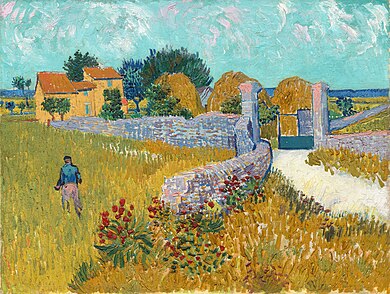
|
Farmhouse in Provence, also known as Entrance Gate to a Farm with Haystacks, is an oil-on-canvas painting by Dutch painter Vincent van Gogh, produced in 1888, at the height of his career. It was painted while Van Gogh was living in Arles, in southern France. Partially due to having been inspired by painter Adolphe Monticelli, he sought the Provence region of France to further expand his painting skill and experience. Van Gogh used several pairs of complementary colors in the painting, the color contrast bringing an intensity to his work. The painting now hangs in the National Gallery of Art in Washington, D.C., as part of the Ailsa Mellon Bruce Collection. Painting credit: Vincent van Gogh
Recently featured:
|
August 8

|
The Cuban green woodpecker (Xiphidiopicus percussus) is a species of bird in the family Picidae. It is the only species within the genus Xiphidiopicus and is endemic to Cuba. A distinctive, relatively small woodpecker of the general size and shape of a sapsucker, the Cuban green woodpecker occasionally appears crested, with bright olive-green overparts and yellow underparts. The nape and upper breast are bright red, with some black bases to feathers usually visible, with a black chin and throat; the crown is red in males and black with white stripes in females. Females are significantly smaller than the male and generally shorter-billed. Juveniles are generally duller in plumage, showing more barring and streaking below. It typically measures 21 to 25 cm (8.3 to 9.8 in) in length and weighs 48 to 97 g (1.7 to 3.4 oz). This picture shows a female X. p. percussus individual. Photograph credit: Charles J. Sharp
Recently featured:
|
August 9

|
Béatrice et Bénédict is an opéra comique in two acts by French composer Hector Berlioz. Berlioz wrote the French libretto himself, based closely on Shakespeare's Much Ado About Nothing. He had been interested in setting Shakespeare's comedy since his return from Italy in 1833, but only composed the score of the opera following the completion of Les Troyens in 1858. It was first performed at the opening of the Theater Baden-Baden on 9 August 1862. Berlioz conducted the first two performances of a German version in Weimar in 1863, where, as he wrote in his memoirs, he was "overwhelmed by all sorts of kind attention". This picture is the title page of the first edition vocal score of Béatrice et Bénédict, published in 1863, with an illustration by French illustrator Antoine Barbizet. Illustration credit: Antoine Barbizet; restored by Adam Cuerden
Recently featured:
|
August 10

|
Skokloster Castle is a Swedish Baroque castle built between 1654 and 1676 by the wealthy military commander Carl Gustaf Wrangel, located on a peninsula of Mälaren, a lake between Stockholm and Uppsala. It was designed mainly by Caspar Vogel; other architects involved included Jean de la Vallée and Nicodemus Tessin the Elder. The castle is a monument to the Swedish Age of Greatness, a period in the middle of the 17th century when Sweden expanded to become one of the major powers in Europe. Wrangel's death in 1676 meant that the castle was never truly completed. The castle became a state museum in the 1970s and displays collections of paintings, furniture, textiles and tableware, as well as books and weapons. Photograph credit: Marcin Szala
Recently featured:
|
August 11
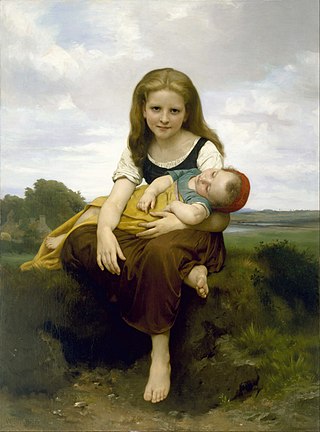
|
The Elder Sister is an oil-on-canvas painting by French academic artist William-Adolphe Bouguereau, produced in 1869. The painting shows a girl (the "elder sister") sitting on a rock and holding a sleeping baby on her lap, with a quiet rural landscape behind them. For this scene, Bouguereau's daughter Henriette and son Paul served as models. Bouguereau used great care and attention in drawing the children's features and the positioning of their bodies, giving them an idyllic look. The girl's eyes look directly at the viewer and both children are shown with immaculate clothing. The painting is now in the permanent collection of the Museum of Fine Arts, Houston. Painting credit: William-Adolphe Bouguereau
Recently featured:
|
August 12

|
The Eagle Nebula is a young open cluster of stars in the constellation Serpens, discovered by Jean-Philippe Loys de Cheseaux in 1745–46. Both the "Eagle" and the "Star Queen" refer to visual impressions of the dark silhouette near the centre of the nebula, an area made famous by the "Pillars of Creation" imaged by the Hubble Space Telescope. The emission nebula contains several active star-forming gas and dust regions, including the aforementioned pillars. This picture of the Eagle Nebula is a three-colour composite mosaic image, based on photographs taken by the Wide Field Imager camera of the MPG/ESO telescope at La Silla Observatory. The area imaged in Pillars of Creation can be seen in the centre, along with other star-forming regions, as well as a large number of stars in front of, in or behind the nebula. Photograph credit: European Southern Observatory
Recently featured:
|
August 13

|
The BMW S1000RR is a sport bike made by BMW Motorrad. It was introduced in 2008, initially for competition in the 2009 Superbike World Championship, and has been in commercial production since then. Powered by a 999 cc (61.0 cu in) four-cylinder engine, redlined at 14,200 rpm, it delivers 133.6 kW (179.2 hp; 181.6 PS) to the rear wheel, making it the most powerful motorcycle in the class. Rubén Xaus and Troy Corser rode the bike for its inaugural Superbike World Championship in 2009, gaining highest finishes of fifth and seventh respectively, but it achieved greater success in the 2010 FIM Superstock 1000 championship season, with rider Ayrton Badovini winning every single race but one on the S1000RR. Photograph credit: Stefan Krause
Recently featured:
|
August 14

|
Lyriothemis acigastra is a species of dragonfly in the family Libellulidae, found in India. Until 2013, it was thought to be restricted to the northeastern states of Assam and West Bengal, but it has now also been recorded in the southern state of Kerala. It is a small dragonfly with brown-capped greenish-yellow eyes and a blackish-brown thorax marked with yellow. Laterally, there are three stripes. Its wings are transparent, palely tinted with yellow at the base. The female is similar to the male, but the abdomen is cylindrical instead of tapered from base to end and reddish yellow instead of blood red. This picture shows a male L. acigastra individual. Photograph credit: Jeevan Jose
Recently featured:
|
August 15
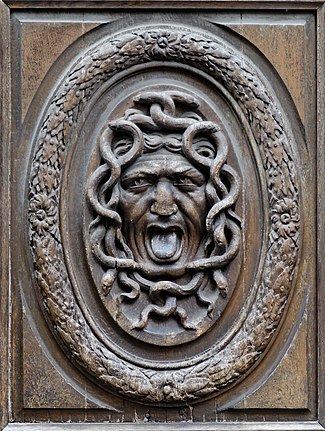
|
In Ancient Greece, the gorgoneion was a special apotropaic amulet showing the head of a Gorgon, used most famously by the Olympian deities Athena and Zeus: both are said to have worn the gorgoneion as a protective pendant. It was assumed, among other godlike attributes, as a royal aegis to imply divine birth or protection, by rulers of the Hellenistic age, as shown, for instance, on the Alexander Mosaic and the Gonzaga Cameo. This picture shows a wooden door panel with a carving of a gorgoneion, intended to guard the house from unwanted guests. It is located at the Hôtel Amelot de Bisseuil in Paris and was created around 1660 by French sculptor Thomas Regnaudin. Photograph credit: Marie-Lan Nguyen
Recently featured:
|
August 16

|
Diospyros kaki, also known as the persimmon or the Oriental persimmon, is the most widely cultivated species of the genus Diospyros. The persimmon is a sweet, slightly tangy fruit with a soft to occasionally fibrous texture. Although its first botanical description was not published until 1780, D. kaki is among the oldest cultivated plants, having been in use in China for more than 2000 years. In some rural Chinese communities, the fruit is seen as having a great mystical power that can be harnessed to cure headaches, back pains and foot ache. This species, native to China, is deciduous, with broad, stiff leaves. Cultivation extended first to other parts of East Asia, including Japan, where it is very popular. It was later introduced to California and southern Europe in the 19th century and later to Brazil in the 1890s. Photograph credit: Frank Schulenburg
Recently featured:
|
August 17

|
Gene Kranz (born August 17, 1933) is an American aerospace engineer, former fighter pilot, and retired flight director and manager for NASA. Kranz served as NASA's second chief flight director, directing missions of the Gemini and Apollo programs, including the first lunar landing mission, Apollo 11. He is best known for directing the successful efforts by the Mission Control team to save the crew of Apollo 13; he was later portrayed in the major motion picture of the same name by actor Ed Harris. He is also noted for his close-cut flattop hairstyle and the dapper "mission" vests (waistcoats) of different styles and materials made by his wife, Marta Kranz, for his flight director missions. This picture, taken in 1965, shows Kranz at his console in the Mission Operations Control Room, Mission Control Center, Houston, during a simulation to prepare for the Gemini 4 mission. Photograph credit: NASA; restored by Adam Cuerden
Recently featured:
|
August 18

|
Gabrielle Cot is an oil-on-canvas painting by William-Adolphe Bouguereau, produced in 1890. The eponymous subject is the daughter of the French painter Pierre Auguste Cot, who was Bouguereau's most notable pupil. He started the work as a study for another painting but decided to develop it into a full work after becoming enthralled by Gabrielle Cot's charm and beauty. It was the only non-commissioned painting he ever painted. Bouguereau gifted the painting to Gabrielle Cot's grandmother, Madame Duret, and it has been privately held since then. It was exhibited to the public in Paris in 1891 and in New York in 1999. Painting credit: William-Adolphe Bouguereau
Recently featured:
|
August 19

|
The longnose batfish (Ogcocephalus corniger) is a species of batfish found at depths between 29 and 230 m (95 and 755 ft) in the Atlantic Ocean, ranging from North Carolina to the Gulf of Mexico and the Bahamas. Like other members of the family Ogcocephalidae, it has a flat triangular body and coloring varying from yellowish to purple with pale, round spots and lips of orange-red. Photograph credit: Betty Wills
Recently featured:
|
August 20
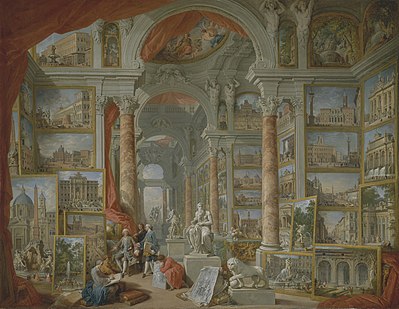
|
Modern Rome is a name given to each of three almost identical oil-on-canvas paintings by Italian artist Giovanni Paolo Panini, originally produced as pendant paintings to Ancient Rome for his patron, the comte de Stainville, who was the French ambassador to Rome from 1753 to 1757. The first two versions of the painting were created for Stainville in 1757, while the third was painted a couple of years later for Claude-François de Montboissier de Canillac de Beaufort. This picture is the second version of Modern Rome, part of the collection of New York's Metropolitan Museum of Art. The work shows a picture gallery with a large number of paintings and sculptures depicting contemporary buildings and monuments in Rome, including St. Peter's Square, the Trevi Fountain, Santa Maria Maggiore, Piazza Navona, Michelangelo's Moses and a Medici lion. Stainville is depicted in an armchair in the left of the gallery. The first version of the painting is in the Museum of Fine Arts, Boston, while the third is in the Louvre in Paris. Painting credit: Giovanni Paolo Panini
Recently featured:
|
August 21

|
The solar eclipse of August 21, 2017, was a total solar eclipse visible within a band that spanned the entire contiguous United States, passing from the Pacific to the Atlantic coasts. As a partial solar eclipse, it was visible on land from Nunavut in northern Canada to as far south as northern South America. In Africa and northwestern Europe, it was partially visible in the late evening. In Asia, it was visible only at the eastern extremity, the Chukchi Peninsula. Prior to this event, no solar eclipse had been visible across the entire contiguous United States since June 8, 1918; not since the February 1979 eclipse had a total eclipse been visible from anywhere in the mainland United States. The path of totality, up to about 70 miles (110 km) wide, touched 14 states, while the rest of the U.S. experienced a partial eclipse. This picture shows the solar eclipse during totality as seen from outside Crowheart, Wyoming. The image is a composite of multiple exposures, bracketed to show both the Sun's corona and the surface features of the new moon itself, illuminated by earthshine. A few solar prominences are visible around the lunar limb. Photograph credit: Michael S. Adler
Recently featured:
|
August 22

|
SMS Arcona was a member of the Carola class of steam corvettes built for the German Kaiserliche Marine (Imperial Navy) in the 1880s. Intended for service in the German colonial empire, the ship was designed with a combination of steam and sail power for extended range, and was equipped with a battery of ten 15-centimeter (5.9 in) guns. Arcona was laid down at the Kaiserliche Werft (Imperial Shipyard) in Danzig in 1881, she was launched in May 1885, and she was completed in December 1886. Photograph credit: unknown; restored by Adam Cuerden
Recently featured:
|
August 23

|
Quedlinburg Abbey was a house of secular canonesses (Frauenstift) in Quedlinburg in what is now Saxony-Anhalt, Germany. It was founded in 936 on the initiative of Saint Matilda, the widow of King Henry the Fowler, as his memorial. For many centuries, the abbey and its abbesses enjoyed great prestige and influence. Quedlinburg Abbey was an Imperial Estate and one of the approximately forty self-ruling Imperial Abbeys of the Holy Roman Empire and was disestablished in 1802/3. Today, the mostly Romanesque buildings are a UNESCO World Heritage Site. Photograph credit: Alexander Savin
Recently featured:
|
August 24

|
Napoleon Crossing the Alps is the title given to the five versions of an oil-on-canvas equestrian portrait of Napoleon Bonaparte, painted by French artist Jacques-Louis David between 1801 and 1805. Initially commissioned by the King of Spain, Charles IV, the composition shows a strongly idealized view of the real crossing that Napoleon and his army made across the Alps in May 1800, through the Great St Bernard Pass in Switzerland. Having taken power in France during the Coup of 18 Brumaire in November 1799, Napoleon was determined to return to Italy to reinforce the French troops in the country and retake the territory seized by the Austrians in the preceding years. The Austrian forces, under Michael von Melas, were laying siege to Masséna's troops in Genoa; Napoleon hoped to gain the element of surprise by taking the trans-Alpine route. By the time his troops arrived, Genoa had fallen, but he pushed ahead, hoping to engage the Austrians before they could regroup. The Reserve Army fought a battle at Montebello in June before eventually securing a decisive victory at the Battle of Marengo. This picture is the fourth version of the painting, produced by David in 1803 for the palace of the Cisalpine Republic in Milan. It was confiscated by the Austrians in 1816 and later installed in the Belvedere, Vienna, where it is now part of the collection of the Österreichische Galerie Belvedere. Painting credit: Jacques-Louis David
Recently featured:
|
August 25
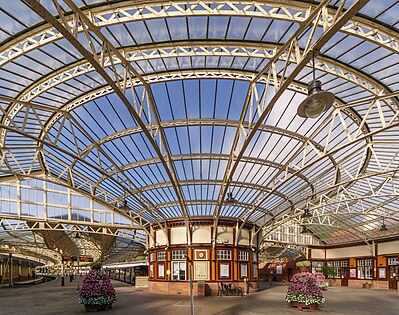
|
Wemyss Bay railway station serves the village of Wemyss Bay in Inverclyde, Scotland. The station is a terminus on the Inverclyde Line, about 26 miles (42 km) west of Glasgow Central. It incorporates the Caledonian MacBrayne ferry terminal connecting mainland Scotland to Rothesay on the Isle of Bute and is managed by Abellio ScotRail. The station was one of only ten to be awarded five stars in Britain's 100 Best Railway Stations by Simon Jenkins. The building was designed by James Miller in 1903 for the Caledonian Railway and is remarkable for its use of glass and steel curves. It is noted for its architectural qualities and, although one of Scotland's finest railway buildings and Category A listed, it has suffered from neglect. A major refurbishment scheme carried out jointly by Network Rail, Inverclyde Council and the Scottish Government from June 2014 to the spring of 2016 has seen the station buildings and adjacent ferry terminal fully restored. This picture shows the station concourse, with the ticket office and glass roof. Photograph credit: Colin
Recently featured:
|
August 26

|
Polystichum setiferum, also known as the soft shield-fern, is an evergreen or semi-evergreen fern native to southern and western Europe. The Latin specific epithet, setiferum, means 'with bristles'. The species is frequently cultivated as an ornamental plant for use in gardens. This picture shows a new leaf of the P. setiferum cultivar 'Cristato Pinnulum', about 30 cm (12 in) in height. Photograph credit: Dominicus Johannes Bergsma
Recently featured:
|
August 27

|
|
North Cascades National Park is an American national park in the state of Washington. At more than 500,000 acres (200,000 ha), North Cascades National Park is the largest of the three National Park Service units that comprise the North Cascades National Park Complex. North Cascades National Park consists of a northern and southern section, bisected by the Skagit River that flows through Ross Lake National Recreation Area. Lake Chelan National Recreation Area lies on the southern border of the south unit of the park. In addition to the two national recreation areas, other protected lands including several national forests and wilderness areas, as well as Canadian provincial parks in British Columbia, nearly surround the park. North Cascades National Park features the rugged mountain peaks of the North Cascades Range, the most expansive glacial system in the contiguous United States, the headwaters of numerous waterways, and vast forests with the highest degree of flora biodiversity of any American national park. This picture is a panoramic map of North Cascades National Park, as viewed from the east, created in 1987 by Austrian painter and cartographer Heinrich C. Berann for the National Park Service. Map credit: Heinrich C. Berann
Recently featured:
|
August 28

|
George Villiers, 1st Duke of Buckingham (28 August 1592 – 23 August 1628), was an English courtier, statesman and patron of the arts. He was a favourite and possibly also a lover of King James I of England. Despite a patchy political and military record, Buckingham remained at the height of royal favour for the first three years of the reign of King Charles I, until a disgruntled army officer assassinated him. This picture is an oil-on-panel portrait of Buckingham by Dutch painter Michiel Jansz. van Mierevelt, produced around 1625. Buckingham commissioned portraits of himself as "a medium for the cultivation of his personal image". In this painting, he is depicted with a jacket encrusted with pearls that also hang in ropes across it; it may also contain a reference to his diplomatic coup that year in negotiating the marriage of the future Charles I. At his entry to the French court, he is recorded as wearing a grey velvet suit from which the loosely threaded pearls dropped to the ground as he advanced to make his bow to the queen, to general wonder. The painting is now in the collection of the Art Gallery of South Australia. Painting credit: Michiel Jansz. van Mierevelt
Recently featured:
|
August 29

|
The Rho Ophiuchi cloud complex is a dark nebula of gas and dust that is located 1° south of the star Rho Ophiuchi in the constellation Ophiuchus, bordering Scorpius, rising above the plane of the Milky Way in the night sky. At an estimated distance of 131 ± 1 parsecs, this cloud is one of the closest star-forming regions to the Solar System. This picture is an infrared image of the Rho Ophiuchi cloud complex in false color, captured by NASA's Wide-field Infrared Survey Explorer (WISE) mission. The emission nebula in the center glows bright white due to heating from nearby stars, while the red object in the bottom right is a reflection nebula caused by light from the star Sigma Scorpii being reflected off the surrounding dust. The bright pink objects just left of center are young stellar objects, many still enveloped in their own compact nebulae. |
August 30

|
Goryeo ware refers to all types of Korean pottery and porcelain produced during the Goryeo dynasty, from 918 to 1392, but most often refers to celadon (greenware). Celadon techniques were first introduced from China; Goryeo potters established a native style by the 12th century. One of these native styles is characterized by the sanggam technique, a way of inlaying that was unique to Goryeo celadon. The color of the celadon, called bisaek for 'green', was also highly admired. The celadon industry arose and declined as the Goryeo dynasty developed. A large number of wares were produced at the Gangjin Kiln Sites in southwestern Korea. This picture shows a 12th-century celadon pitcher produced during the Goryeo dynasty, with the head of a dragon and the body of a fish. The pitcher has been catalogued as a National Treasure of South Korea and forms part of the collection of the National Museum of Korea. Pitcher credit: unknown; photographed by the National Museum of Korea |
August 31

|
The black-bellied whistling duck (Dendrocygna autumnalis) is a species of whistling duck that breeds from the southernmost United States and tropical Central America to south-central South America. In the U.S., it can be found year-round in peninsular Florida and parts of southeast Texas, as well as seasonally in southeast Arizona and Louisiana's Gulf Coast. Since it is one of only two whistling duck species native to North America, it is occasionally just known as the "whistling duck" or "Mexican squealer" in the southern United States. Photograph credit: Charles J. Sharp
Recently featured:
|
Picture of the day archives and future dates